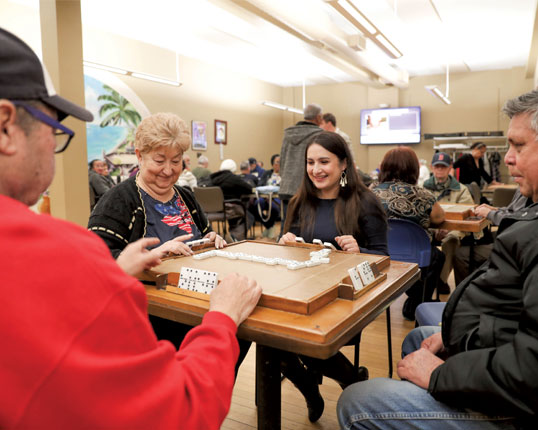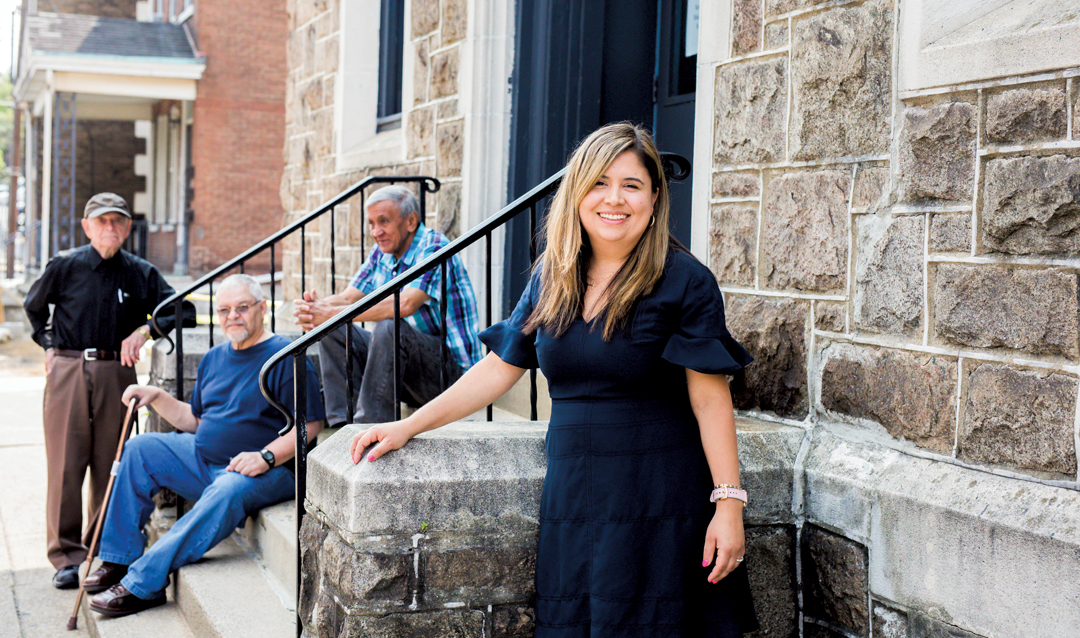On the same Wednesday that Kawash and the other Lehigh tutors were helping with homework at Cathedral Church, two of Lehigh’s health equity interns were blocks away at the Hispanic Center Lehigh Valley on East Fourth Street. The center and adjacent Fowler Community Wellness Center (St. Luke’s University Health Network is also a partner) are community hubs, where people gather to eat, play dominoes and bingo, get help finding jobs and access medical care and other services.

Nesli Akinci ’19 plays dominoes with South Side residents at the Hispanic Center.
Intern Nesli Akinci ’19, who aspires to be a medical doctor, converses in Spanish with some of the older people at the center as she joins in a game of dominoes. She hopes to add Zumba classes and other activities at the center to get participants to move more. Many of them, she says, want to try new things.
“My overall goal as a health equity intern is ultimately to improve the overall health of the seniors,” says Akinci. “It’s very important to get their input as well, so I’ll ask them, ‘What types of things do you want to see at the senior center? Do you want more arts activities? Do you want people to come in to give educational talks?’”
Intern Matthew Kravitz ’20, who plans to pursue a career in healthcare administration, helps with administrative work. He is creating a book of policy procedures and structures for the Hispanic Center to follow, and he will also help to secure grants, write thank-you letters to donors and assist with some of the financial responsibilities.
Health equity intern Nesli Akinci ’19 talks about her community interactions at the Hispanic Center.
The internships are part of the Health, Medicine, and Society program at Lehigh, which brings faculty from across colleges together to offer courses in medical sociology, bioethics and a host of other fields. In the classroom, students learn that people’s health is influenced not only by their body processes, but also by social determinants. At the center, Akinci and Kravitz learn firsthand about those complexities of health, such as the difficulty in accessing programs for those who lack transportation.
“What I have learned from working with people in the community, and just interacting, both here and at the clinic, is that you just have to listen to people and give them your attention and just be there for them,” Akinci says. “They really appreciate that.”
Kravitz says that community involvement has been one of the most impactful experiences he has had at Lehigh, as he learns more about what’s important to those living on the South Side and how residents interact with one another. He has encouraged his fellow students to become more involved too. For the four years that students are at Lehigh, he says, the South Side is their home.

Victoria Montero, executive director of the Hispanic Center, says Lehigh’s support is essential for her organization’s continued success in South Bethlehem.
“Part of making a home your home is making community,” he says.
Victoria Montero, executive director of the Hispanic Center, says the partnerships with Lehigh faculty, staff and students and other organizations help the center to serve more people and improve its operations. Lehigh faculty also have forged relationships there. The goal is to improve the quality of life for South Side residents.
“There is a lot of work to be done, so it is important that we continue to work together,” says Montero, who grew up on the South Side after immigrating from Mexico at age 14. “If we continue to work together, we are going to make an impact on the community. We can’t do it alone, we can’t. The Hispanic Center can’t do it without its partners.”
Victoria Montero, executive director of the Hispanic Center, talks about the impact of the center’s partnership with Lehigh.


